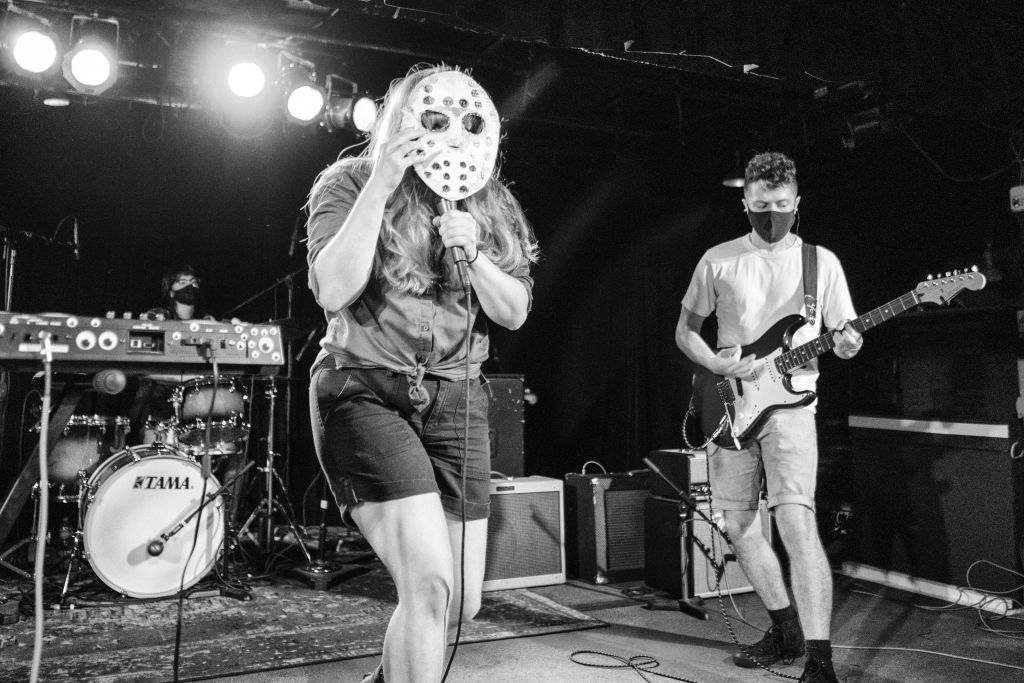Music
 Bacchae's Katie McD + Andrew Breiner at Black Cat. Photo courtesy of band.
Bacchae's Katie McD + Andrew Breiner at Black Cat. Photo courtesy of band.
Punk’s Not Dead: An Inside Look at D.C.’s DIY Scene
November 1, 2021 @ 12:00pm
Colorful mohawks, piercings, combat boots, and most of all, fast-tempo music riddled with political and anti-establishment lyrics all come to mind with the word “punk.” While this still holds true for some, it’s a narrow assumption for a scene that has evolved into a vast network of musical and fashion styles over the last 50 years.
Defining the Undefinable
It’s challenging to track all of the subgenres with punk roots — there’s alternative rock, indie, emo, heavy metal, pop punk and industrial rock, just to name a few. But even more difficult is grouping them together under one label — a nearly impossible task according to Black Cat’s Dante Ferrando, who has been supporting the independent music scene through his 14th Street venue since 1993.
“I think it’s too segmented to say ‘the punk scene,’” says Dante, who entered the world of punk rock with his first band in 1979. “There’s all sorts of little branches. I don’t think everything that has a tendril of punk rock can be considered part of the same scene.”
His wife Catherine Ferrando, also a co-owner of Black Cat, agrees and adds that giving the punk community a solid definition is somewhat of an oxymoron.
“I do think there’s something a little antithetical about trying to define it,” says Catherine, who joined D.C.’s punk scene when she moved to the city in 1992. “If somebody considers themselves punk, who am I to say they’re not?”
Mike Maguire, a D.C. photographer and regular punk show attendee, started frequenting concerts in the ’80s and ’90s when he lived in Northern Virginia. He returned to D.C. in 2006 and says compared to back then, DIY is a more accurate label for what could be considered today’s punk scene in D.C.
“If someone didn’t know better and saw the word punk, they might think of ’70s and ’80s mohawks and only one type of music, but that’s not how it is in D.C.,” Maguire says. “It’s more about bands doing their own thing, but it all still came out of the big-name punk of the D.C. scene.”
Bacchae is Born
Local punk band Bacchae formed in 2016 at the onset of this new wave. At the time, Katie McD (vocals and keys), Eileen O’Grady (drums) and Andrew Breiner (guitar) lived together and were searching for a bassist.
Then, Breiner met Rena Hagins at Hat Band DC, an annual event where musicians of all skill levels are randomly grouped and perform a set of one to three songs a few weeks later. Hagins had just started playing bass and had never been in a band before — and Breiner’s welcoming spirit made her feel comfortable and accepted. She jumped at the opportunity to join Bacchae.
Hagins and Breiner say this open and accepting attitude can be found throughout D.C.’s punk and hardcore community. Breiner adds while there isn’t any gatekeeping based on skill level or experience, it isn’t accurate to describe the scene as tight-knit.
“That can sound exclusive,” Hagins says. “It’s open, and people are patient and understanding that not everyone is a virtuoso.”
The two were surprised at the amount of support they received in Bacchae’s early days. They were in it for fun and didn’t expect to carve out a space for themselves in such a welcoming community.
The DIY Philosophy
This idea of doing it for yourself and the music — not for the money — is a common theme. The Ferrandos, who are one-half of the newly formed D.C. punk band The Owners, say this philosophy is particularly strong in D.C.
“The philosophy that music is the goal in itself and not a way to money or fame is definitely part of punk,” Catherine says. “You’re not going to just be a pawn of some record company. You’re going to do your own thing. You can do it how you want to do it.”
The Black Cat owners try their best to run the club this way — but they also must turn a profit. Dante says the business side of punk has become a lot more cookie cutter over the years, so following your own path is more important now than ever.
“That’s always been a part of Black Cat: not putting profit at the absolute forefront,” Dante says. “We try to do things differently, and hopefully some people realize you can.”
End of An Era
Don Zientara, the former owner of D.C. punk scene staple Inner Ear Recording Studios, believes that punk can mean “a different thing to different people.” But at its core, punk is all about “being true to yourself and being real.”
“The whole idea [of punk] is to just be real.”
This mantra was at the heart of Inner Ear’s philosophy for 31 years until it permanently closed its doors in October 2021. Dubbed “the Abbey Road of D.C.’s punk scene” by the Washington Post, Arlington County bought Inner Ear in April along with the lot adjacent to the studio. County officials have hinted at parks, new public art, and expanded opportunities for arts and cultural programming.
In a Washington Post article, Zientara says the one-story building that housed the studio was no great loss in itself — but he will miss the area. He says closing Inner Ear helps make way for the newer punk generation.
“Let somebody else do some good recording,” he says. “Why should I stand in the way? I’m an old fart.”
MacKaye says he spent thousands of hours in sessions with Zientara — time that is almost impossible to replicate without the studio.
“I may never find [the same thing], but it reminds me such times exist and they’re out there to be found.”
Zientara says while he hates to use the word “document,” he thinks of his role in the punk scene as an arbiter to help artists translate the music they had in their heads onto tape so their message could be heard.
For the Message, Not for the Profit
Recording punk music for the purpose of documentation is a sentiment MacKaye holds along with Zientara. This philosophy was in the forefront of MacKaye’s mind when he formed Dischord Records back in 1982. He and his friends just wanted to record a tape so they could hold onto their memories. He says it was almost like a yearbook, in a way. They had no intention of selling it.
MacKaye says punk isn’t about the profit or the commodification of music. It’s about the message, going against the grain and being a free place “where new ideas can be presented and profit isn’t part of the equation.” In his opinion, live shows offer space for the spontaneous combustion of ideas and are at the center of punk culture.
“Sometimes [when] you’re in a room with a bunch of people, shit just pops off in a way that’s unexpected — and it’s profound,” MacKaye says. “That’s the thing I always loved. There were moments of almost unexpected celebration where you think, ‘Oh my god, this is such a great moment to be alive.’”
Hagins feels similarly. To her, punk is all about the music — the energy felt at live shows and the visceral sense of collaboration between bands and their audiences is second to none.
“Live performance is the most important thing about punk,” the bassist says. “It’s the most collaborative music scene I’ve experienced because everyone is part of the performance.”
Pandemic Blues
When the pandemic hit the U.S. and national shutdowns closed the doors of D.C.’s venues, Hagins says most of the scene was put on hold. Bacchae played their last show at Songbyrd Music House only a few days before the shutdowns in March 2020 — according to Hagins, it was a packed house, and in retrospect, probably not a great idea with coronavirus going around.
The band planned to set off on a nationwide tour last year to showcase their latest release, “Pleasure Vision,” but like so many other music artists, they had to cancel. And once shutdowns dragged on for months and months, Breiner says it was hard to feel like they were progressing as a band because playing their instruments together and performing at live shows “was out of the question.”
Feeling aimless and not jiving with practicing via Zoom, Bacchae didn’t really play together as a band for about a year, save for passing some cover song recordings back and forth.
“I think there was a shift to online performances and livestreams, which I personally wasn’t able to fully jump headfirst into because I really like being in a physical space,” Hagins says. “Behind a computer screen, it wasn’t translating well — especially for punk and hardcore.”
Maguire, who enjoys photographing bands in the DIY scene, says many of his friends didn’t play their instruments as often anymore because their motivator for doing so — performing live — vanished.
“I know a lot of musicians who didn’t even touch their instrument during the pandemic,” he says. “It was really tough. If they didn’t have anyone in the room to play with, they just didn’t do it. Even the transition back to shows has been pretty slow for a lot of people.”
D.C. venues like Black Cat and Songbyrd have been cautiously getting back into the swing of things since the summer, but Hagins says house shows are still practically nonexistent.
“I’m wondering how [house shows are] going to shift and expand once people feel more comfortable going into someone’s house,” she says. “There are smaller venues with that feel, but nothing replaces the house.”
The loss of intimacy that goes along with playing music in someone else’s living room with 100 people dancing along — and the departure of Inner Ear — have been huge hits to the punk scene, but there’s still hope for the future.
The Future of Punk
Moving forward, Dante is excited to see local bands emerge on the scene and more people going out to shows. Catherine hopes the younger generation will keep punk alive, adding she worries fewer kids are teaching themselves how to play instruments and forming bands because there are so many other avenues of creativity out there now.
Maguire can’t wait for the return of house shows and wants to see more fans join the scene. Hagins and Breiner are ready to get back onstage to feel that connection with the crowd only live performances can provide.
And MacKaye envisions somewhat of a hardcore renaissance taking place once in-person restrictions fade away. He compares the pandemic to a blizzard — when the storm hits, everything stops and it serves as a time to pause and reflect. But when it all melts away, everything comes back to life.
“When the coast is clear, I suspect there will be a burst of energy,” MacKaye says. “[Punk] will take root because it can’t be stopped.”
Today’s punk/hardcore community definitely looks a lot different from the movement’s origins in the early ’80s, but its core philosophies remain: Be true to yourself, experiment with new ideas and do it for fun, not for fame and money. You could call it punk or hardcore, or even DIY, but no matter how you label it, D.C.’s counterculture isn’t going down without a fight.
“Punk is definitely here to stay,” Hagins says. “D.C. has such a strong history of punk. People look to the past to inform the present.”
Follow Bacchae on Twitter and Instagram @Bacchaeband. Find them on Facebook at fb.com/bacchaeband and visit bacchae.bandcamp.com to stream their latest release “Pleasure Vision.”
Follow Black Cat on Twitter @BlackCatDC and visit blackcatdc.com for more information.
Follow Dischord Records on Twitter @dischordrecords and on Facebook at fb.com/dischordrecords. Visit dischord.com for more information.
View Maguire’s portfolio on his website mmaguirephoto.com. Follow him on Twitter @MikeSpeaks and Instagram @mike.j.maguire.
For more info on D.C.’s punk scene, check out @dcpunkarchive and @punkhousedc on Instagram.







